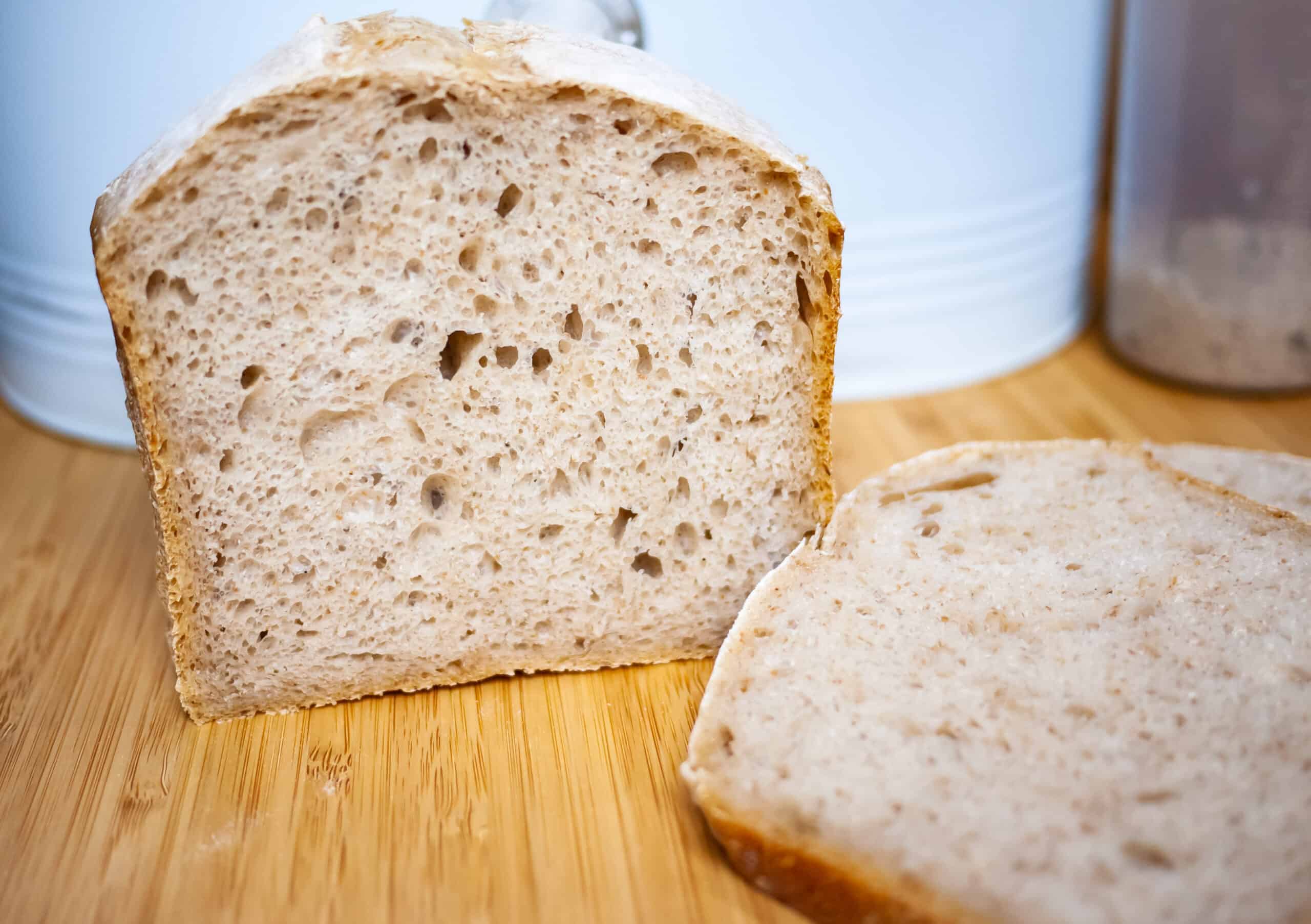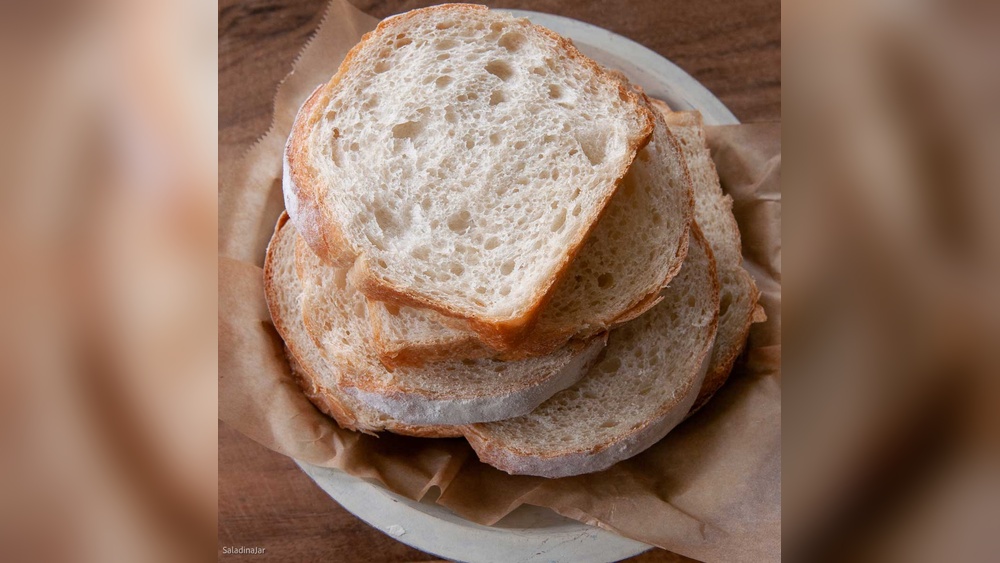Have you ever wondered if you can make sourdough bread right in your bread maker? If you love the idea of fresh, tangy sourdough but feel daunted by the traditional process, you’re not alone.
The good news is, your bread maker might be the secret to baking delicious sourdough with less hassle. Imagine waking up to the smell of homemade sourdough, crafted with ease and precision. Keep reading, and you’ll discover how to make this happen—and why your bread maker could become your new favorite kitchen tool.

Credit: www.pantrymama.com
Sourdough Basics
Sourdough bread has a rich history and a unique flavor. It is different from regular bread because it uses natural fermentation. This process creates a tangy taste and a chewy texture. Understanding sourdough basics helps you decide if you can make it in a bread maker.
The science behind sourdough is simple but special. It involves wild yeast and good bacteria working together. These create bubbles that make the dough rise without commercial yeast. Let’s explore what sourdough really is and what it needs.
What Is Sourdough?
Sourdough is bread made from a natural mix of flour and water. It ferments over time with wild yeast and bacteria. This mix is called a starter. The fermentation gives sourdough its sour taste and airy texture. It is a slow process but creates deep flavor.
Key Ingredients
The main ingredients are simple: flour, water, and salt. Flour provides food for the yeast and bacteria. Water activates the fermentation process. Salt adds flavor and controls fermentation speed. No commercial yeast is used in true sourdough recipes.
Role Of Starter
The starter is the heart of sourdough bread. It contains wild yeast and lactic acid bacteria. This mix ferments the dough, helping it rise naturally. The starter also adds the bread’s signature tangy flavor. Maintaining a healthy starter is key for good sourdough.

Credit: saladinajar.com
Bread Maker Essentials
Bread makers simplify the bread-making process. They mix, knead, and bake dough automatically. This saves time and effort, especially for beginners. Understanding bread maker basics helps you decide if it fits your sourdough needs.
Each bread maker has unique traits. Knowing how they work and what features matter can improve your baking results. Let’s explore these essentials.
How Bread Makers Work
Bread makers have a built-in paddle that kneads dough. They control temperature and time to bake bread evenly. You add ingredients, select a program, and start the machine. The maker does the hard work while you wait.
Most models use a heating element at the bottom. This heats the bread pan to bake the dough inside. Timers and sensors adjust the process for different bread types. This keeps the bread soft and fresh.
Types Of Bread Makers
Basic bread makers have simple settings for white and whole wheat bread. They cost less but offer fewer options. Advanced models have multiple programs for gluten-free, sourdough, and dough-only cycles.
Some bread makers include dual paddles for better kneading. Others come with larger pans for bigger loaves. Choose a type that matches your baking style and family size.
Features To Look For
Check for a programmable timer to start baking later. This helps prepare fresh bread for breakfast. A viewing window lets you watch the dough rise without opening the lid.
Removable, non-stick pans make cleaning easier. Adjustable crust settings allow you to choose light, medium, or dark crust. Noise level matters if you bake early morning or late night.
Some bread makers offer a fruit and nut dispenser. It adds ingredients at the right time automatically. These features improve convenience and bread quality.
Making Sourdough In A Bread Maker
Making sourdough in a bread maker is possible and can be quite rewarding. This method saves time and effort while still producing tasty bread. The process needs some adjustments to get the best results. Understanding your bread maker and sourdough basics is key.
Starter Preparation
Start with a healthy sourdough starter. Feed it regularly to keep it active. Use equal parts water and flour. Let it sit at room temperature for about 4 to 6 hours. The starter should be bubbly and smell tangy before using it. This ensures good fermentation and rise.
Choosing The Right Program
Most bread makers have a sourdough or artisan bread setting. Select this if available. If not, use a basic dough program. It allows longer fermentation and kneading cycles. Avoid quick bake programs, as they do not suit sourdough. Timing is important for good texture and flavor.
Adjusting Ingredients
Sourdough recipes need less yeast or none at all. The starter provides natural yeast. Adjust water to keep dough slightly sticky but manageable. Use bread flour for better gluten development. Salt is essential for flavor and to control fermentation. Add ingredients carefully for best results.
Common Challenges
Slow rising can occur if the starter is weak. Warm the bread maker slightly to help fermentation. Dough may stick to the pan; use non-stick spray or oil. Bread might be dense if fermentation is too short. Experiment with times and ingredients to improve.
Tips For Success
Making sourdough in a bread maker can be fun and rewarding. Success depends on a few key tips. These tips help you bake bread with great taste and texture.
Maintaining Starter Health
Your sourdough starter needs care to stay active. Feed it regularly with equal parts flour and water. Keep it at room temperature for best results. Discard some starter before each feeding to avoid overgrowth. A healthy starter creates good rise and flavor in bread.
Timing And Temperature
Timing is important for sourdough baking. Let the dough rise slowly in the bread maker. Use the right temperature setting, usually around 75°F to 80°F. Too hot or cold can stop yeast from working well. Follow your bread maker’s sourdough program for best results.
Troubleshooting
Sometimes sourdough bread may not rise or taste right. Check if your starter is bubbly and smells fresh. Adjust water or flour if dough feels too sticky or dry. Make sure the bread maker settings match sourdough needs. Try again with small changes to improve your bread.
Recipe Ideas
Exploring sourdough recipes for your bread maker opens a world of tasty possibilities. You can create simple breads or experiment with flavors and grains. Each recipe suits the bread maker’s unique baking process.
Try a basic sourdough loaf first to understand the texture and taste. Then, add whole wheat for a healthier option. Finally, explore flavored loaves for something special and different.
Basic Sourdough Bread
Start with a simple recipe using flour, water, salt, and your sourdough starter. Mix the ingredients and place them in the bread maker. Set the cycle for sourdough or dough to let it rise slowly. This loaf has a crispy crust and soft inside. Perfect for sandwiches or toast.
Whole Wheat Variation
Use whole wheat flour to add fiber and nutrients. Substitute half or all of the white flour with whole wheat. This bread tastes nuttier and has a denser texture. Add a bit more water, as whole wheat absorbs more. Great for a healthy breakfast or snack.
Flavored Sourdough Loaves
Enhance your sourdough with herbs, seeds, or dried fruits. Mix rosemary, garlic, or thyme for savory notes. Add sunflower seeds or flaxseeds for crunch. Sweet options include raisins or chopped nuts. These loaves bring variety and excitement to your bread maker baking.

Credit: www.mygreekdish.com
Cleaning And Maintenance
Cleaning and maintenance keep your bread maker in good shape. They help you make better sourdough bread every time. Proper care stops smells and old dough buildup. This section shows how to clean your machine, store your starter, and extend the life of your bread maker.
Cleaning The Bread Maker
Unplug the bread maker before cleaning. Remove the bread pan and kneading blade. Wash these parts with warm, soapy water. Use a soft cloth to wipe the inside. Avoid using harsh scrubbers that can damage the surface. Dry all parts well before putting them back. Clean the outside with a damp cloth only. Regular cleaning stops mold and keeps your bread fresh.
Storing The Starter
Keep your sourdough starter in a glass jar. Cover it loosely to let air in. Store it in the fridge if you bake less often. Feed the starter once a week to keep it alive. For daily baking, keep the starter at room temperature. Use clean utensils to avoid contamination. Proper storage keeps your starter strong and active.
Extending Bread Maker Life
Use the bread maker gently and avoid overloading. Always follow the manufacturer’s instructions for use. Check the kneading blade regularly for damage. Replace worn or broken parts quickly. Keep the machine dry and dust-free. Store the bread maker in a cool, dry place. Good care helps your bread maker work longer and better.
Frequently Asked Questions
Can I Use A Bread Maker For Sourdough Bread?
Yes, you can make sourdough in a bread maker. Choose a machine with a sourdough or custom setting for best results. It simplifies mixing and baking but requires manual starter preparation.
How Do I Prepare Sourdough Starter For Bread Makers?
Prepare your sourdough starter separately using flour and water. Feed it regularly until bubbly and active. Add the mature starter to your bread maker for mixing and baking.
What Settings Work Best For Sourdough In Bread Makers?
Use the sourdough or custom dough setting on your bread maker. This allows longer fermentation and proper kneading. Avoid quick or basic settings, as sourdough needs slow, controlled rising.
Can I Skip Kneading When Making Sourdough In Bread Makers?
No, kneading is essential for gluten development in sourdough. Bread makers handle kneading automatically, ensuring proper dough texture and rise without manual effort.
Conclusion
Yes, you can make sourdough in a bread maker. It takes time and patience to get it right. The machine helps mix and bake evenly. You still need to feed your starter regularly. Adjusting settings may be necessary for perfect results.
Homemade sourdough tastes fresh and feels rewarding. It’s a simple way to enjoy baking at home. Give it a try and learn as you go. Baking sourdough in a bread maker is both fun and satisfying.

